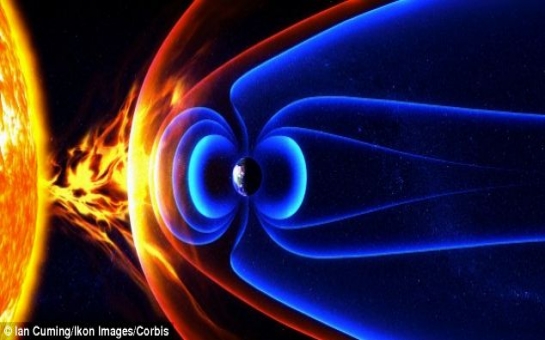Follow us !
Earth's magnetic field is collapsing and it could affect the climate
Society
10:45 | 28.01.2014

Earth's magnetic field is collapsing and it could affect the climate
Deep within the Earth, a fierce molten core is generating a magnetic field capable of defending our planet against devastating solar winds.The protective field extends thousands of miles into space and its magnetism affects everything from global communication to animal migration and weather patterns.But this magnetic field, so important to life on Earth, has weakened by 15 per cent over the last 200 years. And this, scientists claim, could be a sign that the Earth’s poles are about to flip.Experts believe we're currently overdue a flip, but they're unsure when this could occur. If a switch happens, we would be exposed to solar winds capable of punching holes into the ozone layer. The impact could be devastating for mankind, knocking out power grids, radically changing Earth’s climate and driving up rates of cancer.‘This is serious business’, Richard Holme, Professor of Earth, Ocean and Ecological Sciences at Liverpool University told MailOnline. ‘Imagine for a moment your electrical power supply was knocked out for a few months – very little works without electricity these days.’The Earth's climate would change drastically. In fact, a recent Danish study believes global warming is directly related to the magnetic field rather than CO2 emissions.The study claimed that the planet is experiencing a natural period of low cloud cover due to fewer cosmic rays entering the atmosphere.Radiation at ground level would also increase, with some estimates suggesting overall exposure to cosmic radiation would double causing more deaths from cancer.Researchers predict that in the event of a flip, every year a hundred thousand people would die from the increased levels of space radiation.'Radiation could be 3-5 times greater than that from the man-made ozone holes. Furthermore, the ozone holes would be larger and longer-lived,' said Dr Colin Forsyth from the Mullard Space Science Laboratory at UCL.The magnetosphere is a large area around the Earth produced by the planet’s magnetic field. It presence means that charged particles of the solar wind are unable to cross the magnetic field lines and are deflected around the Earth.Space agencies are now taking the threat seriously. In November, three spacecraft were launched as part of the SWARM mission to uncover how the Earth’s magnetic field is changing.The mission plans to provide better maps of our planet's magnetic field and help scientists understand the impact of space weather on satellite communication and GPS.‘Whilst we have a basic understanding of the interior of the Earth, there is much we still don’t know,’ said Dr Forsyth.‘We do not fully understand how the Earth’s magnetic field is generated, why it is variable and the timescales of these variations.’The mission will provide a current map of Earth’s magnetic field. But historic evidence of its decline has already been found in a surprising source – ancient pottery.Scientists have discovered that ancient pots can act as a magnetic time capsule. This is because they contain an iron-based mineral called magnetite. When pots form, the magnetite minerals align with the Earth’s magnetic field, just like compass needles.By examining pottery from prehistory to modern times, scientists have discovered just how dramatically the field has changed in the last few centuries.They’ve found that Earth’s magnetic field is in a permanent state of flux. Magnetic north drifts and every few hundred thousand years the polarity flips so a compass would point south instead of north.If the magnetic field continues to decline, over billions of years, Earth could end up like Mars - a once oceanic world that has become a dry, barren planet incapable of supporting life.But scientists claim the rate of decline is too fast for the Earth’s core to simply burn out. Instead, the story told by ancient pottery suggests the Earth's poles could be about to undergo another flip.According to the British Geological Survey, the Earth's magnetic field has on average four or five reversals in polarity every million years and we’re now overdue a similar event.‘At the moment, we cannot accurately determine whether or not the Earth’s field is about to flip,’ said Dr Forsyth. ‘We have only been recording the Earth’s field for around 170 years; about 1-15 per cent of the time a flip is expected to take.’If a flip occurs, it would cause the Earth’s magnetic shield to be weakened for thousands of years, opening up our defences and causing cosmic radiation to get through. 'We have a double layer defence shield,' Jim Wild a space scientists at Lancaster University. 'Space is full of stuff that’s not great for biological tissue. If we didn’t have an atmosphere, that stuff would be hitting us. It’s the magnetic field protects atmosphere from the solar wind.'‘Some speculative studies have suggested that as the Earth’s magnetic field weakens we could see an increase in cloud coverage in the troposphere and an increase in the polar ozone holes,’ added Dr Forsyth.‘This would be particularly evident in the northern hemisphere where up to 40 per cent of the ozone within the hole region could be lost, far greater than the current losses.’In fact, in one area, there is evidence that a flip is already occurring. ‘The increasing strength of the South Atlantic anomaly, an area of weak field over Brazil, is already a problem,’ said Professor Holme. ‘Satellites flying over have far more problems than in other locations. Astrophysical satellite are just switched off in this location, but from my perspective, this isn’t much good if you want to study the Brazilian rainforest.’'The very highly charged particles can have a deleterious effect on the satellites and astronauts,' added Dr Mona Kessel, a Magnetosphere discipline scientist at Nasa. Scientists however, are quick to point out that while a magnetic flip could cause problems for mankind, the event won’t be a catastrophic.‘We’ve had many reversals in the past, and haven’t been able to show that they had anything to do with, for example, mass extinctions,’ said Professor Holme.And not all of the effects will be bad. The much sought-after spectacle of an aurora would be visible every night all over the Earth as solar winds hit the atmosphere.There remains, however, much work yet to be done in understanding the properties of the deep Earth.The Earth’s core is a hostile world where the crushing forces and temperatures, similar to that of the surface of the sun, take our scientific understanding and abilities to the limit.'This isn't some crazy theory that might happen,' said Professor Wild. 'There is evidence, but we still need to do more science to understand the impact...I'm confidence we can come up with a solution.'(dailymail.co.uk)ANN.Az










